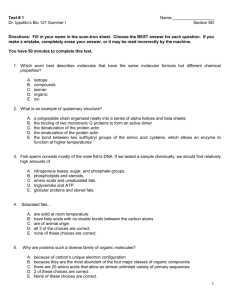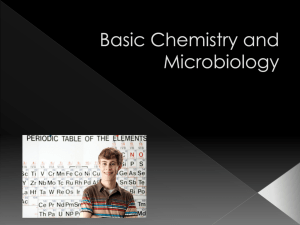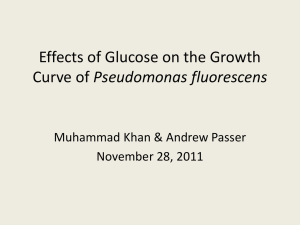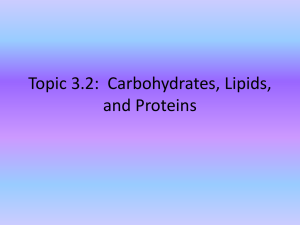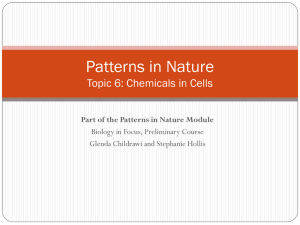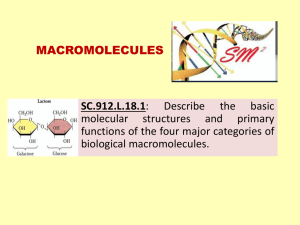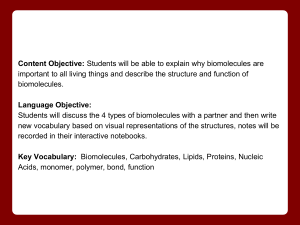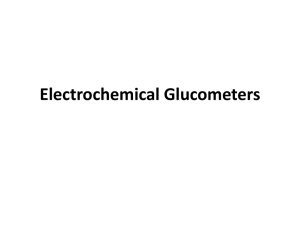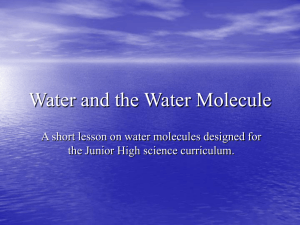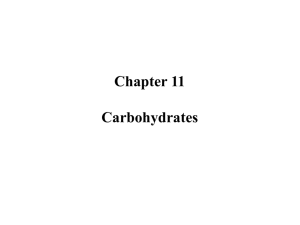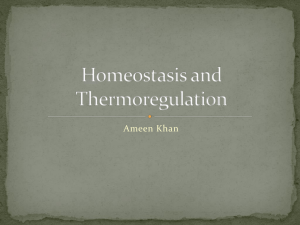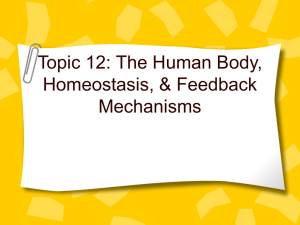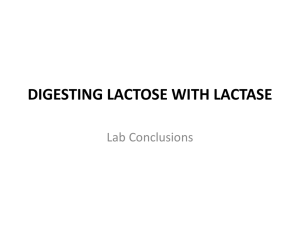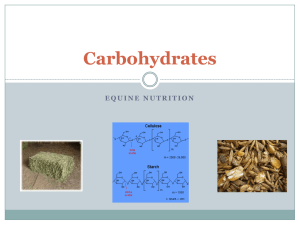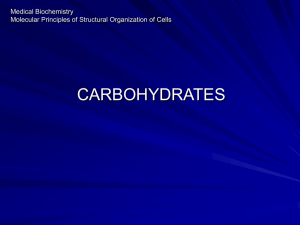(3-D Molecules (key))
advertisement
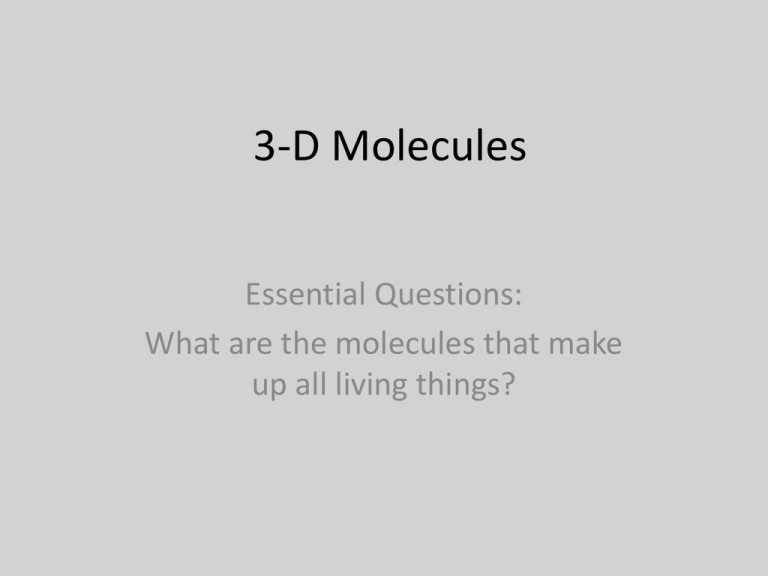
3-D Molecules Essential Questions: What are the molecules that make up all living things? 1. Click on “Monosaccharides” in the Carbohydrates section, then click on the “Glucose” button. Right-click, select “Style,” then “ball & stick” and rotate it. a. What chemical elements is glucose made of? How many atoms of each element are there in one molecule of glucose? (See color key above) 6 carbon, 12 hydrogen, 6 oxygen C6H12O6 1b. What is glucose, and why is it important to ALL life on Earth? • The sugar plants make in photosynthesis. • Glucose at beginning of ALL food chains. • ALL living things get energy from glucose. 2. Click on “Back to Index,” then “Disaccharides,” then “Sucrose.” Change Style to “ball and stick” and rotate it. a. What elements is sucrose (table sugar) made of? How many atoms of each element in one sucrose molecule? 12 carbon, 22 hydrogen, 11 oxygen C12H22O11 b. Glucose is a monosaccharide; it is one simple sugar molecule based on a ring of carbon atoms. How many carbon rings do you see in a sucrose molecule? What do we call this kind of sugar? 2 disaccharide 3. What are the two main forms of carbohydrates and what is the main function of carbohydrates in living things? Sugars and starches Main source of energy for all living things 4. Click on “Back to Index,” then “Polyaccharides,” then “Glycogen” and click on the button in that section with a movie camera on it to see an animation. a. Change style to “ball and stick” and rotate it. To zoom in, press the Shift key and slide your finger up and down the scroll bar on the right side of your mousepad. How does a glycogen molecule compare in size to a glucose molecule? Way bigger b. How does your body use glycogen? To store extra glucose in the liver glucose 5. Go back to Index and click on “Fatty acids” in the Lipids section. Click on the “X” button next to “palmitic acid” to see a saturated fat. Change display to “ball & stick” and rotate it. What elements is palmitic acid made of? How many atoms of each element? 16 carbon, 32 hydrogen, 2 oxygen 6. Click on the “X” button next to “oleic acid” to see an unsaturated fat. Change display to “ball & stick” and rotate it. What elements is oleic acid made of? How many atoms of each element? 18 carbon, 34 hydrogen, 2 oxygen 7. Which kinds of fat are considered less healthy in your diet, saturated or unsaturated? Why is this so? Do you see anything in their molecular structures that may explain why this is so? • Saturated • Saturated fats clog arteries • Sat. fat molecules straight, stack easier to form solid layers on artery walls. 8. What are the two main forms of lipids and what is the main function of lipids in living things?? • Fats and oils • Store energy • Forms cell membranes 9. Go back to Index and click on “Hemoglobin” in the Proteins section. Change display to “ball & stick” and rotate it. a. How does this protein molecule compare in size to sugar molecules? Lipids? Way bigger than both Where in your body is Hemoglobin found? 9b. Change Style to “Cartoon.” Right-click again and select “Color,” then “Cartoon,” then “Amino Acid.” Each different colored section you see represents an amino acid. How many different amino acids are there in hemoglobin? List the colors you see. 11: gray, white, green, blue, teal, blue-gray, orange, red, violet, peach, yellow 9c. What is an amino acid? Building block of proteins; proteins are chains of amino acids. 10. Proteins are often referred to as the “workhorses of the body” because of the many functions they perform. Explain at least four different functions of proteins in living things. • Building materials for all cells, tissues • Help transport things in and out of cells • Help fight diseases (antibodies) • Control rate of chemical reactions (enzymes) 11. Go back to Index and click on “DNA” in the Nucleic Acids section. Change Style to “ball and stick.” What chemical elements is DNA made of? Click on “Color Schemes” at bottom of menu on right side to see color key for elements. Carbon, hydrogen, oxygen, nitrogen, phosphorus 12. Use the mousepad to rotate the DNA molecule. How would you describe its shape? • Double helix • Twisted ladder, spiral • corkscrew 13. What is the function of DNA in living things? • Carries genetic information for traits passed from parents to offspring ( hair color, eye color, etc.) 14. Which three chemical elements were found in all the molecules you observed? Which one forms the “backbone” of all these molecules? • Carbon, hydrogen, oxygen • Carbon 15. Take a look at the food pyramid below. What kind of foods are good sources of carbohydrates? Lipids? Proteins? Carbohydrates: Lipids: Bread, cereal, rice, pasta Fats, oils, meat, poultry, dairy, fried foods Proteins: Meat, poultry, fish, dairy, dry beans, eggs, nuts 16. Why do you think it’s important to balance your diet with foods from all these groups? Can’t get all the nutrients your body needs from one group. Need to eat from all groups to get all the nutrients you need. News Reports: Fructose vs. Glucose • Fructose may lead to overeating http://seattletimes.com/html/nationworld/2020037233_fructos eeatingxml.html#.UOUcMJwQbpY.facebook • Cancer cells prefer fructose to glucose http://www.reuters.com/article/2010/08/02/cancer-fructoseidAFN0210830520100802 Questions?


